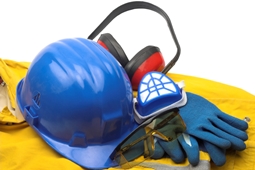You Need Protection from Head to Toe
In order to reduce the risk of exposure to a variety of hazards, Personal Protective Equipment (PPE) should be used for bodily protection of eyes, face, ears, head and extremities. PPE may also involve protective clothing, respiratory devices and protective shields and barriers.
Employees should wear and use PPE where required and when necessary. Equipment must be inspected before use and maintained in working condition.
For the Eyes and Face
-
Goggles and face protection (shields, glasses or full-face respirators) must be worn when working with flying particles, chemicals, liquids or other dangerous materials and bright lights.
-
Eye protection should be fit to an individual or adjustable to provide complete and comfortable coverage. Tint can also be applied to eye protection, protecting from glare when working in bright areas, but should never be used in low-light areas.
-
Always make sure eye and face protection is in working condition. Replace any cracked eyewear or shields.
For the Head
-
Hard hats must be worn when overhead hazards are present.
-
The suspension of a hard hat, which consists of the headband and strapping, helps to absorb impact. It is vital the suspension is adjusted to fit well on the head and keep space above the head to help with impact absorption.
-
Earplugs or noise-reducing ear muffs should be worn in high-noise environments.
For the Feet and Hands
-
Tight fitting foot and hand protection prevents against hazardous objects or substances falling onto your feet or hands that could crush, pierce or burn you.
-
If you work in an environment with wires or connections, metal-free, nonconductive shoes, boots and gloves need to be worn. If there is no risk of electrical contact, steel-toed shoes should be worn.
-
Rubber or synthetic footwear and gloves are needed when working around liquids and chemicals. Leather should be avoided because caustic chemical can eat through the material.
OSHA may require use of certain PPE based on existing hazards. Consult with a professional before making any decision regarding use of PPE.
For more information on personal protective equipment…
OSHA: www.osha.gov/SLTC/personalprotectiveequipment
Princeton University: http://web.princeton.edu/sites/ehs/healthsafetyguide/B4.htm




















